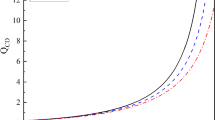Abstract
This work has been initiated by the publication of a review by B.V.Kuteev et al., “Intense Fusion Neutron Sources” [Plasma Physics Reports 36, 281 (2010)]. It is stated that the key thesis of the above review that a spherical tokamak can be recommended for research neutron sources and for demonstration hybrid systems as an alternative to expensive “classical” tokamaks of the JET and ITER type is inconsistent. The analysis of the experimental material obtained during the last 10 years in the course of studies on the existing spherical tokamaks shows that the TIN-ST fusion neutron source spherical tokamak proposed by the authors of the review and intended, according to the authors’ opinion, to replace “monsters” in view of its table-top dimensions (2 m3) and laboratory-level energetics cannot be transformed into any noticeable stationary megawatt-power neutron source competing with the existing classical tokamaks (in particular, with JET with its quasi-steady DT fusion power at a level of 5 MW). Namely, the maximum plasma current in the proposed tokamak will be not 3 MA, as the authors suppose erroneously, but, according to the present-day practice of spherical tokamaks, within 0.6–0.7 MA, which will lead to a reduction on the neutron flux by two to three orders of magnitude from the expected 5 MW. The possibility of the maintenance of the stationary process itself even in such a “weakened” spherical tokamak is very doubtful. The experience of the largest existing devices of this type (such as NSTX and MAST) has shown that they are incapable of operating even in a quasi-steady operating mode, because the discharge in them is spontaneously interrupted about 1 s after the beginning of the current pulse, although its expected duration is of up to 5 s. The nature of this phenomenon is the subject of further study of the physics of spherical tokamaks. This work deals with a critical analysis of the available experimental data concerning such tokamaks and a discussion of the potential possibility of their use in thermonuclear research.
Similar content being viewed by others
References
B. V. Kuteev, P. R. Goncharov, V. Yu. Sergeev, and V. I. Khripunov, Plasma Phys. Rep. 36, 281 (2010).
A. D. Sakharov, Anxiety and Hope (Inter-Verso, Moscow, 1990) [in Russian].
ITER Physics Basis Editors, ITER Physics Expert Group Chairs and Co-Chairs, and ITER Joint Central Team and Physics Integration Unit, Nucl. Fusion 39, 2137 (1999).
E. A. Azizov, in Proceedings of the Workshop on Research Needs for Fusion-Fission Hybrid System, Gaithersburg, MD, 2009, p. 138.
N. A. Uckan, Fusion Technol. 14, 299 (1988).
N. A. Uckan and J. Sheffield, in Tokamak Startup, Ed. by H. Knoepfel (Plenum, New York, 1986), p. 45.
ITER Physics Design Guidelines 1989 (IAEA, Vienna, 1990), p. 10.
E. Nardon, A. Kirk, R. Akers, et al., in Proceedings of the 36th EPS Conference on Plasma Physics, Sofia, 2009, ECA 33E, I2.025 (2009); Plasma Phys. Controlled Fusion 51, 124010 (2009).
J. E. Menard, M. G. Bell, R. E. Bell, et al., in Proceedings of the 21st IAEA Fusion Energy Conference, Chengdu, 2006, Paper OV/2-4.
C. E. Kessel, R. E. Bell, M. G. Bell, et al., Phys. Plasmas 13, 05108 (2005).
J. E. Menard, R. E. Bell, C. Bourdelle, et al., in Proceedings of the 28th EPS Conference on Controlled Fusion, Madeira, 2001, Paper P2-070, ECA 25A, 1765 (2001).
A. Yu. Dnestrovsky, Yu. N. Dnestrovsky, M. Gryasnevich, et al., in Proceedings of the 28th EPS Conference on Controlled Fusion, Madeira, 2001, ECA 25A, 593 (2001).
A. Sykes, in Proceedings of the 17th IAEA Fusion Energy Conference, Yokohama, 1998, Paper OV/2-5.
E. Fredrickson, private communication.
M. Gryasnevich, A. Sykes, and G. Voss, in All-Russian Seminar “Physical and Technical Aspects of a Volumetric Neutron Source for Material-Science and Technological Research and Solution of Nuclear Energy Problems,” Zvenigorod, 2010, Book of Abstracts, p. 39.
B. V. Kuteev, E. A. Azizov, P. N. Alekseev, et al., All-Russian Seminar “Physical and Technical Aspects of a Volumetric Neutron Source for Material-Science and Technological Research and Solution of Nuclear Energy Problems,” Zvenigorod, 2010, Book of Abstracts, p. 13.
M. Gryasnevich, in Proceedings of the Third Fusion-Fission Hybrids Workshop, East-West Science Center of the University of Maryland, MD, 2009.
E. A. Azizov, in Rosatom Ring Table on Nuclear Power: Driver of Innovative Development, Moscow, 2010.
M. Gryasnevich, D. G. H. Goodall, T. C. Hender, et al., in Proceedings of the 22nd EPS Conference on Controlled Fusion and Plasma Physics, Bournemouth, 1995, Vol. 2, p. 77.
I. B. Semenov, S. V. Mirnov, D. Darrow, et al., Phys. Plasmas 10, 664 (2003).
E. J. Strait, T. S. Taylor, A. D. Turnbul, et al., Phys. Rev. Lett. 74, 2483 (1995).
Author information
Authors and Affiliations
Additional information
Original Russian Text © S.V. Mirnov, 2012, published in Fizika Plazmy, 2012, Vol. 38, No. 12, pp. 1011–1021.
Rights and permissions
About this article
Cite this article
Mirnov, S.V. Do spherical tokamaks have a thermonuclear future?. Plasma Phys. Rep. 38, 931–940 (2012). https://doi.org/10.1134/S1063780X12110086
Received:
Accepted:
Published:
Issue Date:
DOI: https://doi.org/10.1134/S1063780X12110086



